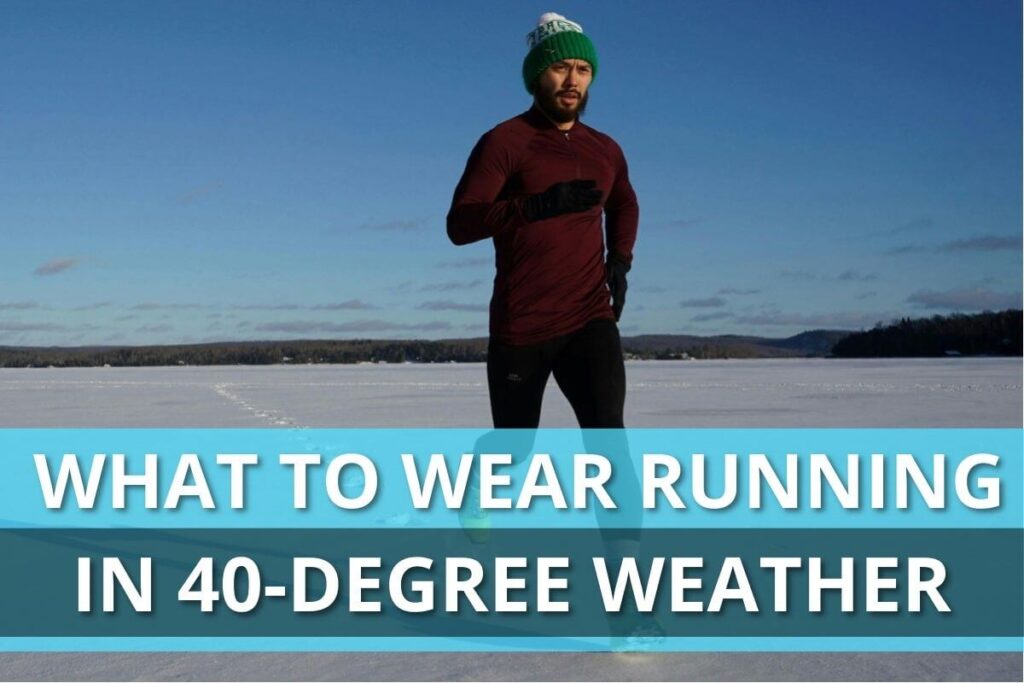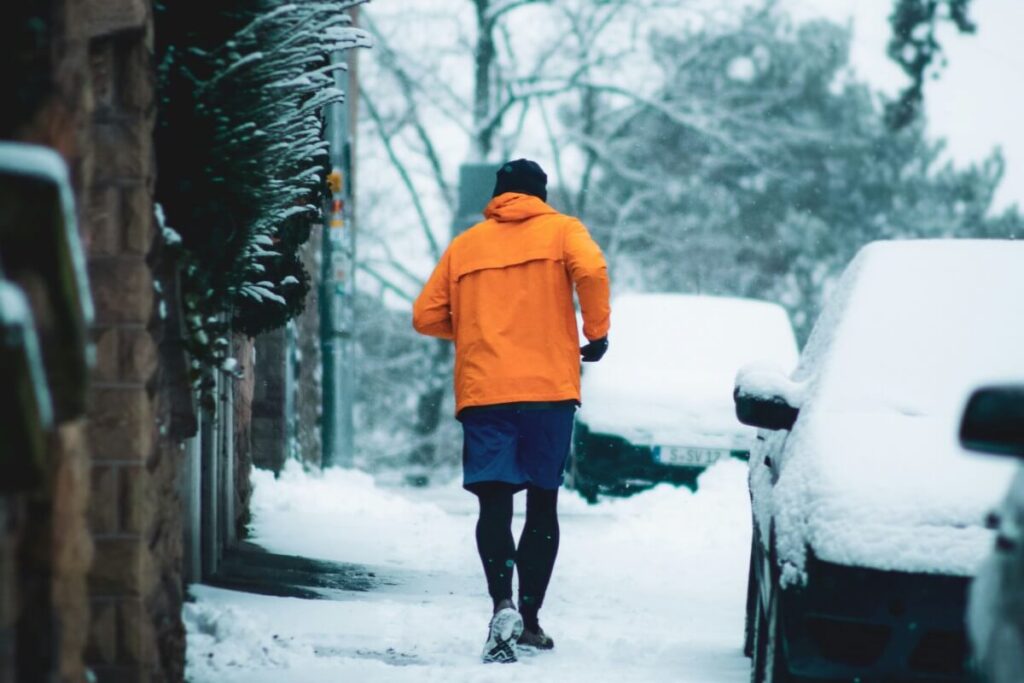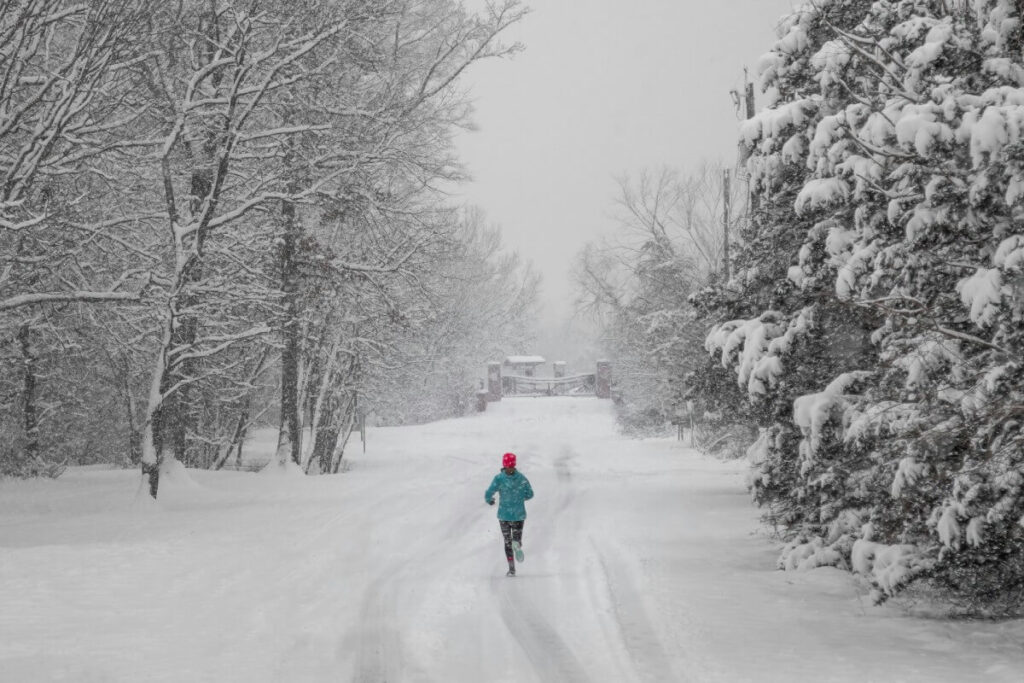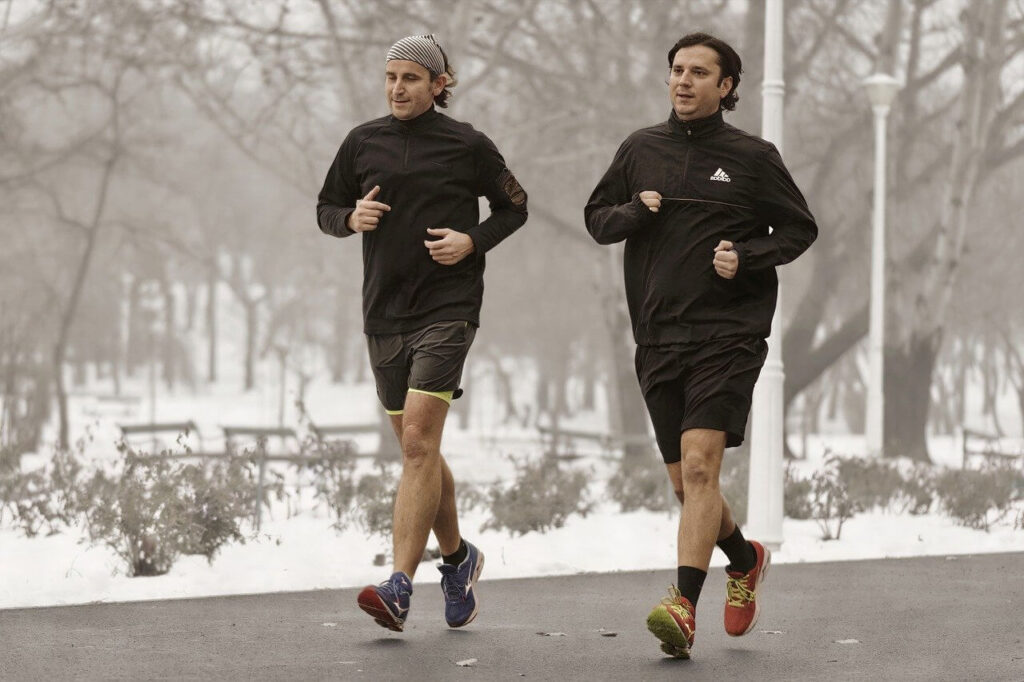What To Wear Running In 40-Degree Weather?
Author:
Unlock your full potential by engaging with our experts and community! Have questions about your fitness journey or looking for expert advice on weightlifting techniques? Don’t hesitate — leave a comment below and Oleksandr Zagrebelnyi will provide a personalized answer and insights to help you reach your goals.
Torokhtiy is reader-supported. Some links are affiliate links, and we may earn a commission at no extra cost to you. See our disclosure page for details.
As the temperature drops, it can be difficult to know what to wear running in 40-degree weather (4°C). Running in the cold can be invigorating and refreshing, but it’s important to dress appropriately. So, how do you know what to wear in 45-degree weather (5°C) in order to enjoy a comfortable run?
This post discusses what to wear when running in cold weather. Stay with us to learn all the details!
What To Wear In 40 Degree Weather? – When picking a 40-degree running outfit, dressing in layers is key to staying comfortable on your run. Start with a moisture-wicking base layer to keep sweat away from your skin. Add a long-sleeve shirt, a lightweight jacket, breathable leggings/pants, and accessories for warmth.

Features Of Running In The Cold Season
Running is an excellent exercise that can be done all year round. During the winter season, the temperature drops, making it harder to run. However, running all year round has numerous benefits, including weight management, reducing the risk of chronic diseases, improving cardiovascular health, and boosting mood.
Low temperatures can make running during the cold season more challenging. When the temperature drops, the body has to work harder to maintain warmth. A run in 40-degree weather (4°C) can make breathing more difficult, and the body may feel stiffer, making moving challenging.
When running in cold weather, it is important to choose the right clothing.
Pro Tip
It is recommended to dress in layers. The first layer should be a moisture-wicking material that will keep sweat away from the skin. The second layer should be a thermal layer that will insulate the body and keep it warm. The third layer should be a windproof and waterproof jacket that will protect you from the cold wind and precipitation.
Running Coach Nike Run Club Kyiv
It is important to note that the ideal temperature for running is between 50°F to 60°F (10°C to 15.5°C). However, you can run in temperatures as low as -20°F (-29°C) with the right clothing. If you experience any chest pain, shortness of breath, or dizziness, it is crucial to stop running immediately.
4. Advantages Of Running In The Cold Season
While many people prefer to run when the weather is warm and sunny, running during the colder months of the year has many benefits. Let’s discuss four advantages of running in the cold season.
✅ Boosts Immunity
Running in the cold can be an excellent way to boost your body’s immunity. Exercising in cold weather can help your body produce more white blood cells, which are responsible for fighting off infections and diseases. Moreover, the cold air can help you breathe more deeply and improve your lung capacity, which can help your body fight off respiratory illnesses.
✅ Burns More Calories
Running in the cold can also help you burn more calories. When exposed to cold temperatures, your body must work harder to maintain its core temperature. This means that your body burns more calories to keep you warm. This is why running in the cold can be an effective way to burn extra calories and lose weight.
✅ Improves Mental Health
Running in the cold can also positively impact your mental health. Cold weather running can help you feel more alert, awake, and energized. Moreover, running in nature during the winter can help you feel more connected to the natural world and reduce stress and anxiety.
✅ Increases Endurance
Running in the cold can also help you build endurance. When you run in colder temperatures, your body has to adjust to the cold air, which can help you build up your endurance and stamina. This can help you run longer distances and improve your overall fitness level.

3. Disadvantages Of Running At 40 Degrees (4°C)
Running at 40 degrees (4°C) can have several disadvantages that runners should consider:
❌ Increased Risk Of Hypothermia
Hypothermia is a condition that occurs when your body loses heat faster than it can produce it, causing the core temperature to drop below normal. Running in cold temperatures increases the risk of hypothermia. When you run in 40-degree weather (4°C), your body loses heat faster, which can lead to hypothermia. Symptoms of hypothermia include shivering, confusion, slurred speech, and loss of coordination. In severe cases, hypothermia can be life-threatening.
❌ Increased Risk Of Injuries
Running in cold temperatures can increase the risk of injuries. When it’s cold, our muscles, tendons, and ligaments become stiff and less flexible, making them more prone to injuries. Running in 40-degree temperatures can increase the risk of injuries such as muscle strains, sprains, and even fractures. Cold temperatures can also cause the ground to become harder, increasing the risk of falls and injuries.
❌ Decreased Lung Function
Running in cold temperatures can also decrease lung function. The cold air can irritate the airways, causing them to constrict, which can make it harder to breathe. Breathing cold air can also cause coughing, wheezing, and shortness of breath. Running in 40-degree weather can be particularly challenging for people with asthma or other respiratory conditions.
Clothing Options For Running At 40 Degrees (4°C)
As the temperature drops, deciding what to wear for a run can be challenging. Running in cold weather requires proper clothing to stay warm and comfortable. When choosing clothing for running in cold weather, it is important to look for specific features.
Look for clothes that are moisture-wicking, breathable, and quick-drying. These features will help you stay dry and comfortable while running. It’s also essential to choose clothes that fit well. Clothes that are too tight or loose can hinder your movement and make running difficult.
It’s important to avoid cotton clothing when running in cold weather. Cotton absorbs sweat and moisture, making it difficult to stay warm. Instead, opt for moisture-wicking synthetic materials that will help keep you dry.
Here are some options for running wear for 45 degrees (5°C) and the features of clothes suitable for running in cold weather.
1. Clothing For The Head, Body, And Hands
When running in 40-degree weather (+4°C), protecting your head, body, and hands from the cold is essential. For the head, a lightweight, moisture-wicking hat is ideal to keep you warm and dry. A beanie or headband that covers your ears is also a great option. When it comes to the body, layering is key.
Pro Tip
Start with a moisture-wicking base layer, followed by a long-sleeved shirt made of breathable material. Finally, add a lightweight, water-resistant jacket to help protect you from the wind. For the hands, gloves made of moisture-wicking material will help keep them warm and dry.
Running Coach Nike Run Club Kyiv
2. Shoes
When running in cold weather, wearing shoes that provide traction on slippery surfaces is important. Look for shoes with a rugged outsole that provides excellent traction and stability. Trail running shoes are also great because they offer more support and traction than regular running shoes. Make sure to wear moisture-wicking socks to keep your feet dry and warm.
3. Eyes
Sunglasses are not only for bright sunlight, but also for cold and windy weather. The wind can cause your eyes to water, making it difficult to see. Polarized sunglasses will help protect your eyes from the wind and glare.
Our Recommendations For 40-Degree Running Outfit
Here are our recommendations for clothing and accessories to use when running in 40-degree weather (4°C).
1. Base Layers
• Men
Nike Men’s M Nk Dry Park20 Pant: These pants are made with Nike Dry fabric that wicks sweat away from your skin to keep you dry and comfortable. They also have a tapered design that provides a streamlined fit to help reduce distractions.
Nike Men’s Dry Training Top: This training top is made with Dri-FIT technology that helps keep you dry and comfortable during your workout. The lightweight fabric also provides a breathable feel that helps you stay cool even when pushing yourself to the limit.
• Women
Adidas Women’s Active Sports Athletic Legging Tight: These leggings are made with a moisture-wicking fabric that helps keep you dry and comfortable. They also have a high-rise waistband that provides a secure fit and coverage when you are on the move.
Adidas Women’s Own The Run Long-Sleeve Tee: This long-sleeve tee is made with a lightweight fabric that provides a comfortable feel. It also has a slim-fit design that gives you a full range of motion while running.

2. Outer Layers
• Men
Adidas Men’s Own The Run Jacket: This jacket is made with a water-repellent coating that helps keep you dry in light rain. It also has a slim-fit design that gives you a streamlined look while running.
• Women
Adidas Women’s Marathon Translucent Jacket: This jacket is made with a translucent fabric that provides a unique look. It also has a slim-fit design that gives you a full range of motion while running.
3. Footwear
• Men
Nike Men’s Trail Running Shoes: These shoes are designed to tackle any terrain, with a durable outsole that provides traction on both wet and dry surfaces. They also have a breathable upper that helps keep your feet cool and comfortable.
• Women
Nike Women’s Revolution 5 Running Shoe: These shoes are made with a lightweight knit fabric that comfortably wraps your foot. They also have a soft foam that cushions your step for a comfortable stride.
4. Hats
New Balance Lightweight Running/Athletic Skullcap Hat, Beanie, Cap Black: This hat is made with a lightweight fabric that provides warmth without adding bulk. It also has a reflective logo that helps keep you visible in low-light conditions. It is suitable for both men and women.
5. Accessories
FITLY Minimalist Running Pack – Running Backpack Phone Holder, Storage, Thoracic Belt: This running pack is designed to hold your phone, keys, and other essentials while you run. Its thoracic belt helps distribute weight evenly across your body for a comfortable fit.

5 Top Tips On How To Prepare For Running In 40 Degrees
40 degrees (4°C) may not seem that cold, but it can still impact your body during your run. Here are five tips on how to prepare for running in 40 degrees (4°C).
1. Warm Up Inside
It’s essential to warm up before you start your run, especially when it’s cold outside. Do a dynamic warm-up indoors to get your muscles ready for the run. This will help prevent injury and make the transition to the cold easier.
2. Hydrate
It’s easy to forget hydration when it is cold outside, but it’s just as important as in the heat. Drink water before and after your run to stay hydrated. You can bring a water bottle on your run if you need to, but make sure it’s insulated to prevent the water from freezing.
3. Protect Your Skin
The cold can be harsh on your skin, so don’t forget to protect it. Use a moisturizer before your run to keep your skin hydrated, and wear sunscreen to protect against UV rays, which can still be damaging, even on cloudy days.
4. Choose The Right Shoes
Choosing the right shoes is essential for any run, especially in cold weather. Look for shoes with good traction to prevent slipping on icy surfaces. You might also want to consider shoes with extra insulation to keep your feet warm.
5. Don’t Forget To Cool Down
Cooling down after your run is just as important as warming up. Take a few minutes to walk or jog slowly to gradually decrease your heart rate and prevent muscle soreness.
FAQ
Is It Too Cold To Run In 40-Degree Weather?
Many people believe that running in cold weather is more harmful than helpful. However, if you dress appropriately and take precautions, you can safely run in 40-degree weather. It’s best to wear layers, a hat, gloves, and warm socks to protect your extremities from the cold.
Is It Okay To Run In Shorts In 40-Degree (4°C) Weather?
It’s important to regulate your body temperature while running, especially in colder weather. While it may be tempting to wear shorts, it’s recommended to dress in layers and wear pants or leggings in temperatures below 50 degrees (10°C). This will help prevent hypothermia and keep you comfortable during your run.
What Should I Wear To Run In 40- To 50-Degree Weather?
If you plan to run in 40- to 50-degree (5-10°C) weather, it’s important to dress appropriately. You should wear light layers you can easily remove as you warm up. A long-sleeved shirt (or a jacket over a short-sleeved shirt) paired with running tights or pants should be sufficient. Don’t forget a hat and gloves to keep your extremities warm!
Conclusion
In conclusion, running is an excellent exercise that can be done all year round. Running during the cold season can be more challenging, but it is still possible with the right clothing and precautions. Running in 40-degree weather can be a great way to stay active and enjoy the crisp fall and winter air.
By dressing appropriately for the conditions, you’ll be able to stay comfortable and focused on your workout. Remember to layer up, protect your extremities, and choose bottoms that strike a balance between warmth and mobility. Happy running!
Have you ever tried to run in 40-degree (4°C) weather? Please share your experience in the comments below.
References:
- Seasonal changes in metabolic and temperature responses to cold air in humans // ScienceDirect: https://www.sciencedirect.com/science/article/abs/pii/S0031938404002136
- Why is it easier to run in the cold? // Taylor & Francis Online: https://www.tandfonline.com/doi/full/10.1080/23328940.2016.1201182
- Running in Cold Weather: Exercise Performance and Cold Injury Risk // Strength and Conditioning Journal: https://journals.lww.com/nsca-scj/Abstract/2020/02000/Running_in_Cold_Weather__Exercise_Performance_and.11.aspx
- Practicing Sport in Cold Environments: Practical Recommendations to Improve Sport Performance and Reduce Negative Health Outcomes // PMC https://www.ncbi.nlm.nih.gov/pmc/articles/PMC8471173/
- Maintained Hydration Status After a 24-h Winter Mountain Running Race Under Extremely Cold Conditions // Frontiers: https://www.frontiersin.org/articles/10.3389/fphys.2018.01959/full
- Photos are made by Andre Morgan, Pexels, Christian Lue, Vlad Tchompalov, Unsplash, Surprising_SnapShots Pixabay
Why Trust Us?
With over 20 years in Olympic weightlifting, strength training, nutrition coaching, and general fitness our team does its best to provide the audience with ultimate support and meet the needs and requirements of advanced athletes and professional lifters, as well as people who strive to open new opportunities and develop their physical capabilities with us.
By trusting the recommendations of our certified experts in coaching, nutrition, and sports training programming, as well as scientific consultants, and physiotherapists, we provide you with thorough, well-considered, and scientifically proven content. All the information given in the articles concerning workout programming, separate exercises, and athletic performance, in general, is based on verified data.
The product testing process is described in more detail here.
Oleksandr is a running coach and member of the Nike Run Club coaching team for 8 years. A participant in national and international competitions at distances from one kilometer to the ultra trail. Owner of mountain trail running camps. Nowadays Oleksandr is responsible for creating running training programs for athletes of various levels, coaching personally offline and online, conducts trail running camps in the mountains, participates in competitions.



Still have questions after reading our article? Unlock your full potential by engaging with our experts and community! Don’t hesitate — leave a comment below and Oleksandr Zagrebelnyi will provide a personalized answer and insights to help you reach your goals.